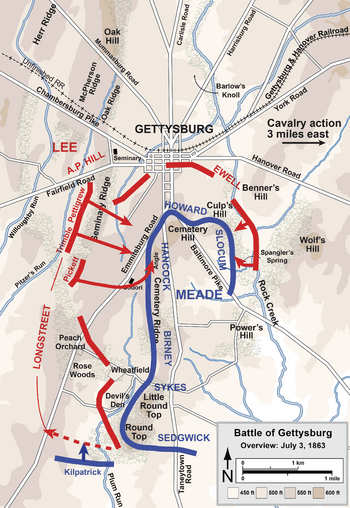Cemetery Ridge facts for kids
Quick facts for kids |
|
|
Cemetery Ridge
|
|
|
U.S. Historic district
Contributing property |
|

Cemetery Ridge
|
|
| Location | Adams County, Pennsylvania |
|---|---|
| Part of | Gettysburg Battlefield Historic District (ID75000155) |
| MPS | Battle of Gettysburg MPS |
| Added to NRHP | March 19, 1975 |
Cemetery Ridge is a famous spot in Gettysburg National Military Park, located just south of Gettysburg, Pennsylvania. It was super important during the Battle of Gettysburg, which happened from July 1 to July 3, 1863. This ridge was the main defensive line for the Union Army (the North) during the battle. It was like the center of their "fish-hook" shaped battle line. The Confederate States Army (the South) tried to attack the Union soldiers here on the second and third days of the battle, but they were stopped each time.
Contents
What is Cemetery Ridge Like?
This ridge isn't very tall, only about 40 feet (12 meters) higher than the land around it. It's also less than 2 miles (3.2 kilometers) long. At its northern end, the ridge goes up to become Cemetery Hill. Towards the south, it slopes down into low, wooded, and sometimes wet ground, just north of Little Round Top.
At the northern part of Cemetery Ridge, there's a small group of trees and a low stone wall. This wall makes two sharp turns. This area is often called The Angle. It's also known as the High Water Mark of the Confederacy. This special spot, along with the nearby Codori Farm, was a key place during Pickett's Charge on the third day of the battle. It was also important during an attack by Confederate Major General Richard H. Anderson's troops on the second day.
Cemetery Ridge in the Civil War
First Day: Union Troops Arrive
On the first day of the Battle of Gettysburg, Cemetery Ridge was empty for most of the day. But then, the Union army had to pull back from their positions north of town. Soldiers from the First Corps, led by Brig. Gen. John C. Robinson and Maj. Gen. Abner Doubleday, were placed on the northern end of the ridge. They protected the left side of the Eleventh Corps on Cemetery Hill.
Later, the Twelfth Corps arrived. Maj. Gen. John W. Geary's division was sent to the southern end of the ridge, close to Little Round Top. Brig. Gen. John Buford's cavalry (soldiers on horseback) set up a skirmish line in the fields between Cemetery Ridge and Seminary Ridge. The Third Corps arrived around 8 p.m. and took over from Geary's division. The Second Corps arrived around 10:30 p.m. and camped right behind the Third Corps.
Second Day: Fierce Fighting
On the second day of the battle (July 2), the commander of the Army of the Potomac (the main Union army), Maj. Gen. George Meade, moved his troops around. He expected a Confederate attack. The Second Corps was placed in the middle of Cemetery Ridge. Brig. Gen. Alexander Hays's division was on the right, John Gibbon's division was in the center near the Angle, and John C. Caldwell's division was on the left, next to the Third Corps. Robinson's division was kept in reserve behind the Eleventh Corps. The Fifth Corps was also held in reserve behind the Second Corps.
In the late afternoon, Confederate Maj. Gen. Lafayette McLaws's attack pushed parts of Maj. Gen. Daniel Sickles's Third Corps back to the southern end of Cemetery Ridge. Brig. Gen. Ambrose Wright's Confederate soldiers even managed to briefly capture the southern part of the Angle. However, they were soon pushed back to Seminary Ridge by the Philadelphia Brigade.
Third Day: Pickett's Charge
On July 3, a huge Confederate artillery (cannon) attack hit Cemetery Ridge. This was before Pickett's Charge. Union cannons on the ridge fired back at Seminary Ridge. Thirty-four Union cannons were damaged. After the cannon fire, three Confederate divisions attacked the Union Second Corps at the "stone fence" near the Angle. These divisions were led by George Pickett, J. Johnston Pettigrew, and Isaac R. Trimble.
Heavy rifle and cannon fire from the Union side stopped most of the Confederates. Only about 250 soldiers, led by Lewis Armistead, managed to break through the Union line. They reached the high water mark of the Confederacy. Sadly, Armistead was badly wounded and later died. Two other Confederate brigades tried to protect Pickett's right side during the charge. They reached a more southern part of the Union line on Cemetery Ridge. But they were also pushed back by the 2nd Vermont Brigade, losing 40% of their soldiers.
After the Battle
After the war, the Gettysburg Battlefield Memorial Association bought land to build a road and place monuments along the ridge. In 1884, the Round Top Branch steam railroad was built across the southern end of Cemetery Ridge. Later, in 1893, the Gettysburg Electric Railway was built across the northern end.
Several army camps were set up on the west side of the ridge near the Angle. For example, Dwight D. Eisenhower's Camp Colt was there in 1918. A large meeting of Civil War veterans also took place there during the 1938 Gettysburg reunion. The 1962 Cyclorama Building at Gettysburg, which had a viewing deck, replaced an older observation tower at Zeigler's Grove on the ridge. However, the Cyclorama Building was closed in 2008.



